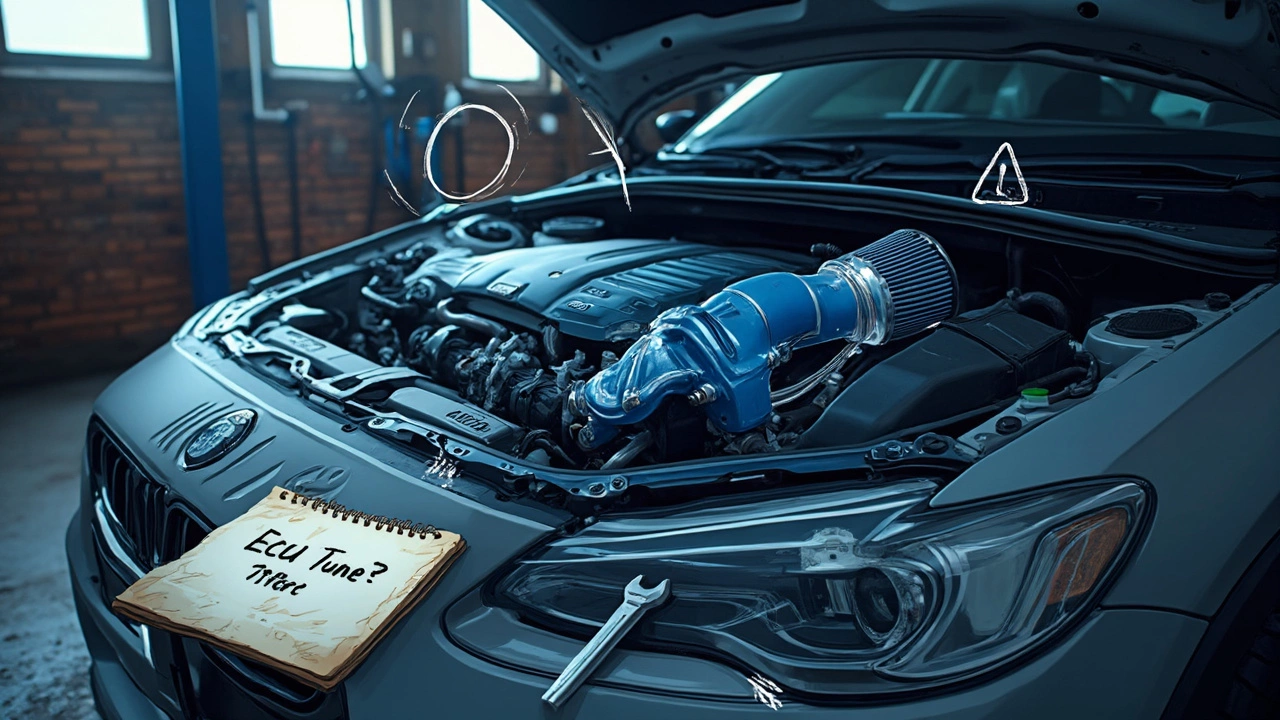You’ve probably seen those cold air intakes at car shows or on your buddy’s ride and wondered if you could just bolt one on your own car without messing with any complicated tunes. The good news? For a lot of cars, it really is as simple as unbolting the old airbox and popping on the new setup, at least on paper.
But here’s the thing—your engine is pretty sensitive, especially with all the sensors and computers running the show these days. Before you jump in, you need to know how your car might react to breathing easier and whether you’ll unlock more power—or just trigger a check engine light. A cold air intake can help your engine draw in cooler, denser air, which is always a win for power, but that’s only part of the story.
It’s easy to find guys who ran a cold air intake for years with no problems and others who ended up chasing weird idle issues, rough running, or bad fuel economy. There's more to this than slapping on new parts.
- What Does a Cold Air Intake Actually Do?
- Do You Need a Tune for a Cold Air Intake?
- What to Watch Out for If You Skip the Tune
- Tips for a Safe and Smooth Install
What Does a Cold Air Intake Actually Do?
So what’s the real deal with a cold air intake? Basically, it’s all about helping your engine breathe better. Instead of pulling in warm air from right next to the engine (where the stock airbox often sits), a cold air intake moves the air filter away from the hot engine and into a cooler spot—usually down near a fender or even behind the front bumper. Colder air is denser, so there’s more oxygen in the same volume, and your engine loves that.
This denser air mixes with fuel to make a bigger bang in each cylinder. That can mean a little bump in horsepower and sharper throttle response. Don’t expect miracles—a straightforward setup might give you 5 to 15 horsepower. Big jumps only happen when you combine it with other mods, like a high-flow custom exhaust or a tune.
Another thing: cold air intakes usually use smoother, wider tubing and less restrictive filters compared to the stock box. Less restriction means the engine works less to suck in air. On turbocharged cars, this sometimes helps the turbo spool faster. Still, a lot depends on the factory design. Some stock airboxes actually flow pretty well, especially on newer models.
Lastly, the sound changes. With a cold air intake, you’ll hear more intake roar—maybe the best part for a lot of folks. It’s a simple mod you can do yourself. But remember, how much you gain depends on your specific vehicle, how the intake is built, and what other mods you have.
Do You Need a Tune for a Cold Air Intake?
Here’s the straight answer: on most stock cars, you can usually install a cold air intake without getting a tune right away. Car makers design the stock engine computer (ECU) to adjust for small changes like a new filter or intake. The ECU uses the mass airflow sensor and oxygen sensors to keep things running in the safe zone. So, for basic bolt-on kits made for your car’s year and model, you’re probably fine skipping a tune.
But the story changes when you dive into more aggressive mods. If you pair your cold air intake with bigger injectors, a turbo, or a custom exhaust that really increases airflow, the computer starts getting lost. Some aftermarket intakes use oversized pipes or move sensors, which can throw off your air-fuel mix. That’s when a tune isn’t just nice, it’s necessary if you want your car running right—and not risk harming your engine or getting lousy fuel mileage.
Let’s break down the most common cases:
- If your intake is a simple, well-matched kit, you can usually bolt it on and drive.
- If the intake has a much bigger diameter, relocates sensors, or is part of other big mods, a tune keeps things balanced.
- Tuned ECUs unleash all the gains you paid for—sometimes you leave horsepower on the table with just a bolt-on.
For some popular cars—especially turbocharged Subarus, EcoBoost Fords, and Mazdaspeed models—even basic intakes can mess with the sensor readings and make the car run too lean. That’s why shops and forums for those brands will almost always recommend a tune if you upgrade the intake.
Check out this quick rundown comparing factory ECUs and how they handle cold air intakes:
| Car Type | OEM ECU Adjusts? | Risks Without Tune | Recommended Tune? |
|---|---|---|---|
| Honda Civic (NA, 2010+) | Yes | Low | No, for basic intake |
| Ford Mustang GT (2015+) | Yes, mildly | Medium | If intake is large diameter |
| Subaru WRX (FA20, 2015+) | Limited | High (leans out fast) | Yes |
| VW GTI (MK7, 2015+) | Yes | Low/Medium | No, unless other mods |
At the end of the day, if you’re unsure, check with folks who mod your exact car—a local tuner, forum, or Facebook group can save you a headache. If your car throws a check engine light or starts acting weird? That’s your sign a tune is overdue.

What to Watch Out for If You Skip the Tune
Going for a cold air intake without a tune sounds cheap and easy, but there are some real things you’ll want to keep an eye on. Not every car freaks out with a new intake, but plenty do—and you won’t always spot the problem right away.
The most common headache? The mass airflow (MAF) sensor gets confused. Most factory ECUs expect airflow to fall inside a narrow range. Toss a bigger or differently placed filter in the mix, and sometimes your air-fuel ratio goes a bit sideways. This can lead to:
- Rough idle or hesitation when you hit the gas
- Worse gas mileage, sometimes up to 10% higher fuel use
- Check engine lights (CEL) for codes like P0171 or P0174—these mean the engine’s running too lean
- In rare cases, even long-term engine knock or misfires
Another thing worth noting: some engines are more forgiving than others. For example, older Hondas and naturally aspirated engines usually handle a cold air intake better than recent turbocharged models or direct injection engines, which tend to freak out with even minor changes.
Here's a quick look at how skipping a tune can affect important engine stuff:
| Potential Issue | How Often It Happens | Why It Matters |
|---|---|---|
| Check Engine Light | Common, especially on newer cars | May trigger limp mode or restrict power |
| Poor Fuel Economy | About 10% drop reported in forums | Higher gas costs over time |
| Engine Knock | Rare, but possible | Can do serious engine damage over time |
| Failed Emissions Test | Possible in strict states | Can keep you off the road if not fixed |
Newer cars are built to meet super-tight emissions standards. If your air-fuel mix is off, you might not pass your next smog check—even if the car seems to run fine.
Pro tip: If you drive something turbocharged, or anything made after about 2015, a tune is not just a nice upgrade—it's almost required unless you like dealing with warning lights and rough driving. For most older rides, you can usually get away with *just* the cold air intake, but keep a close eye on how your car feels and sounds after the install.
If you notice anything off, like weird surges, stalls at lights, or a sudden jump in fuel bills, that’s your cue to either look up custom tuning or swap back the stock setup. Not worth risking expensive repairs.
Watch out for cheap intakes with poor airflow sensors. A poorly engineered kit can mess up readings so badly that even a tune won’t save your cold air intake project. Stick with brands you’ve seen people actually recommend for your exact make and model.
Tips for a Safe and Smooth Install
Getting your cold air intake on without headaches starts with the basics: read the instructions. Most problems come from skipping steps or using the wrong tools. Even guys who've done dozens of mods can get surprised by a new kit.
Check these things before you start wrenching:
- Know your MAF sensor setup. Most modern engines have a Mass Air Flow (MAF) sensor. If you mess up the connection or orientation when swapping in your new intake, your car can run rough or not at all. Always unplug the battery before touching electronics to avoid weird codes.
- Seal it tight. Any gaps or loose clamps in your intake let in unfiltered air, which leads to dirt getting into your engine. A tight seal also keeps your engine from sucking in hot air from the engine bay, which kills the whole point of the upgrade.
- Watch for clearance. Some cold air intakes need more room or different routing than the stock system. Check around moving parts and engine covers so nothing rubs or bangs when you’re driving.
- Protect against water. A low-mounted intake can suck up water when you drive in the rain or hit puddles. That’s called hydrolocking, and it can wreck your engine in seconds. If you’re in a wet climate, look for an intake with a splash shield or hydro shield cover.
Once you’ve got everything bolted up, double-check all connections before starting the car. If your check engine light comes on right after install, scan for codes. Many minor issues come down to loose sensors or forgotten vacuum lines.
Curious about the basic impact on other engines and setups? Here’s a quick table showing what you can expect after a standard install (no tune) on popular car types:
| Engine Type | Typical HP Gain | Check Engine Light Risk | Idle Issues Risk |
|---|---|---|---|
| Honda 4-Cyl (NA) | 2-5 HP | Low | Low |
| Ford EcoBoost (Turbo) | 5-10 HP | Medium | Medium |
| GM V8 (LS) | 8-12 HP | Low | Low |
| Subaru Boxer (Turbo) | 5-8 HP | High | High |
Don’t rush. A solid install takes less than an hour for most setups, but double-checking everything saves you way more time later. Snap some before-and-after pics so you can brag—or troubleshoot, if anything feels off. If you end up with idle issues or power loss, you might need a tune or to recheck your install. Plenty of local shops can do a quick diagnostic for cheap if you get stuck.






